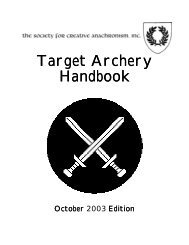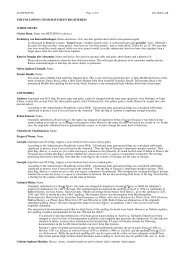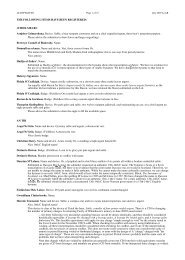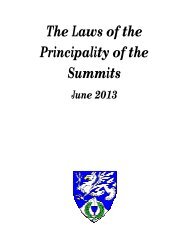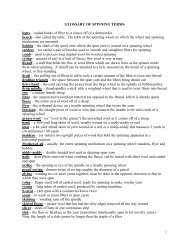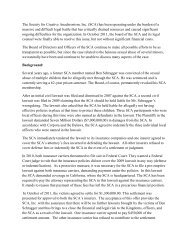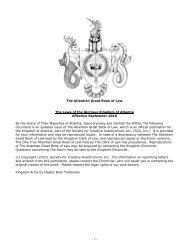The Standards for Evaluation of Names and Armory - SCA Heraldry
The Standards for Evaluation of Names and Armory - SCA Heraldry
The Standards for Evaluation of Names and Armory - SCA Heraldry
Create successful ePaper yourself
Turn your PDF publications into a flip-book with our unique Google optimized e-Paper software.
<strong>The</strong> <strong>St<strong>and</strong>ards</strong> <strong>for</strong> <strong>Evaluation</strong> <strong>of</strong> <strong>Names</strong> <strong>and</strong> <strong>Armory</strong>:<strong>The</strong> Rules <strong>for</strong> Submissionsan eagle is unable to be segreant, which is the equivalent <strong>of</strong> rampant <strong>for</strong> winged quadrupeds.To count as a distinct change, a change <strong>of</strong> posture or orientation among comparable charges mustdistinctly change the appearance <strong>of</strong> a charge. For animate charges, a change in the position <strong>of</strong> the head ortail is not significant; nor is the change from statant to passant, which essentially moves only one leg.Changing from passant to couchant, however, visually removes the legs from the bottom <strong>of</strong> the charge<strong>and</strong> is considered significant. Changes that distinctly affect the number <strong>of</strong> extended wings (from wingsfolded to raised, or from wings seen on one side <strong>of</strong> the body to both sides) are sufficient <strong>for</strong> a distinctchange. Changes which alter the orientation <strong>of</strong> the body or direction <strong>of</strong> facing are generally significant,though some very different descriptions may result in a similar appearance, such as passant bendwise <strong>and</strong>rampant. Also, some postures, such as rampant, have a wide range <strong>of</strong> acceptable depictions which do notcount <strong>for</strong> difference.Groups <strong>of</strong> animate charges or their parts may have comparable postures/orientations as a group even iftheir individual postures are not comparable. For example, there is a distinct change between two groups<strong>of</strong> animate charges or their parts that can be said to be addorsed versus respectant.For example, there is a DC <strong>for</strong> orientation between two lions combatant <strong>and</strong> two hawks addorsed, eventhough a lion cannot be close <strong>and</strong> hawks cannot be rampant. <strong>The</strong>re is a DC <strong>for</strong> orientation between either<strong>of</strong> those <strong>and</strong> two griffin's heads (both to dexter).b. Change <strong>of</strong> Posture <strong>for</strong> Non-Identical Inanimate Charges: Inanimate charges also may be divided intotwo categories: compact charges <strong>and</strong> long charges. Inanimate charges which fall into separate categoriesdo not have comparable postures.Compact charges are generally square or round, such as crescents <strong>and</strong> mullets. Non-identical compactinanimate charges such as pheons <strong>and</strong> crescents are not generally considered to have comparable posturesor orientations. Some compact inanimate charges, like roses <strong>and</strong> mullets, are not considered to havemeaningful orientations.For example, whether a five-pointed mullet has a point to base or chief is blazonable, but does not give adistinct change (DC). For example, there is not a DC <strong>for</strong> orientation between a crescent <strong>and</strong> a pheonbendwise.Inanimate charges with a long axis, like swords <strong>and</strong> arrows, are considered to have some comparableorientations: we give a distinct change <strong>for</strong> orientations that change the direction <strong>of</strong> the long axis <strong>of</strong> thecharge (palewise, fesswise, bendwise, bendwise sinister), but not those that change the direction <strong>of</strong> thepoint or head.For example, there is not a DC <strong>for</strong> orientation between an arrow fesswise <strong>and</strong> a sword fesswise, eventhough each has the point in a different direction. But there is a DC <strong>for</strong> orientation between an arrowpalewise <strong>and</strong> a sword fesswise.c. Change <strong>of</strong> Orientation <strong>for</strong> Identical Inanimate Charges: When comparing two identical types <strong>of</strong>inanimate charges in different orientations, additional differences in posture can also be granted a distinctchange (DC). When the compared charges are identical, compact charges that have clearly distinguisheddirectionality can receive a distinct change <strong>for</strong> differences in facing. Long charges may receive a distinctchange <strong>for</strong> reversing their direction when the ends are easily distinguished. More details may be found inAppendix L.For example, crescents, escallops, <strong>and</strong> pheons are all compact inanimate charges but also have adistinguishable top <strong>and</strong> bottom. Thus, there is a DC <strong>for</strong> orientation between an escallop <strong>and</strong> an escallopinverted <strong>and</strong> between a crescent <strong>and</strong> an increscent <strong>and</strong> a decrescent. For example, axes have easily<strong>St<strong>and</strong>ards</strong> <strong>for</strong> <strong>Evaluation</strong> <strong>of</strong> <strong>Names</strong> <strong>and</strong> <strong>Armory</strong> – April 29, 2012 - Page 66 <strong>of</strong> 73



